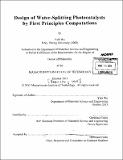Design of water-splitting photocatalysts by first principles computations
Author(s)
Wu, Yabi
DownloadFull printable version (10.60Mb)
Other Contributors
Massachusetts Institute of Technology. Department of Materials Science and Engineering.
Advisor
Gerbrand Ceder.
Terms of use
Metadata
Show full item recordAbstract
This thesis focuses on the design of novel inorganic water-splitting photocatalysts for solar applications using first principles computations. Water-splitting photocatalysts are materials that can photo-catalyze the water-splitting reaction under certain conditions. They provide an alternative way to capture and store the energy from the sun. Currently, the energy conversion efficiency of photocatalytic devices under solar illumination and in pure water (pH=7) is still far from the commercialization target. The design of new photocatalysts with better potentials is the key to solve this problem. We have first developed a so-called three-step method to compute the relative position of a semiconductor's conduction band (valence band) vs. the H₂/H₂O (O₂/H₂O) level in solution from first principles. The merits of the method have been highlighted, and the performance of the method has been tested and compared with the performance of other methods. We conclude that the three-step method provides the desired accuracy for high throughput screening at an acceptable computational cost. We have designed a three-tier first principles high throughput screening system to identify new water-splitting photocatalysts by examining the phase stability, band gap and band edge positions of the candidate compounds. We construct the screening system by integrating the three-step method together with other previously developed methods in our group. We use the system to screen about 3000 different materials. Through the screening, most of the known water-splitting photocatalysts have been reproduced and, more importantly, sixteen new promising candidates have been proposed. Properties of these new candidates have been analyzed and compared to those of the known photocatalysts. Some particularly promising ones are highlighted. Ti₃O₃N₂ is one of the identified candidates from the high throughput screening, and is particularly interesting as it has good phase stability, a low band gap and suitable band edge positions. In addition, it has the same crystal structure as Ta₃N₅ , which is also a photocatalyst with a low band gap. This leads to our study on the Ta₃N₅:Ti₃O₃N₂ solid solution as a water-splitting photocatalyst. Using first principles computations, we study the phase stability, band gap and band edge positions of the solid solution. The results suggest that the Ta₃N₅:Ti₃O₃N₂ solid solution may have a better potential than both its end members as a water-splitting photocatalyst.
Description
Thesis: Ph. D., Massachusetts Institute of Technology, Department of Materials Science and Engineering, February 2014. Cataloged from PDF version of thesis. "October 2013." Includes bibliographical references (pages 90-109).
Date issued
2014Department
Massachusetts Institute of Technology. Department of Materials Science and EngineeringPublisher
Massachusetts Institute of Technology
Keywords
Materials Science and Engineering.